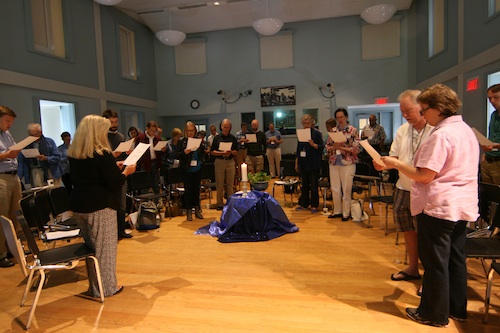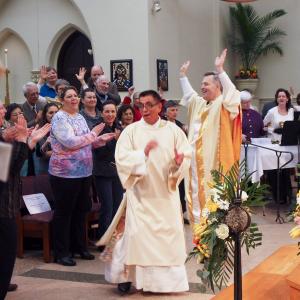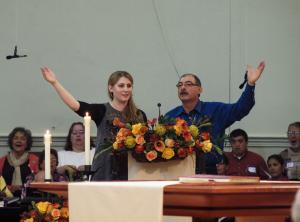
“Somos el Cuerpo de Cristo”: Being the Body of Christ in Worship and Song
by Emilie Coakley, M.A.R. ‘15
 “Christ plays in ten thousand places,” wrote the poet, Gerard Manley Hopkins, “lovely in limbs, and lovely in eyes not his.” Quoting from Hopkins’s “As Kingfishers Catch Fire,” Reverend Robert Oldershaw, Pastor Emeritus of Saint Nicholas Parish in Evanston, IL, pointed to the body—multi-lingual, diverse, and dynamic—at the heart of St. Nick’s proposal for the 2014 Congregations Project, “Building Up the Body of Christ with Hearts and Voices.” Somos el Cuerpo de Cristo – We are the Body of Christ, the parish’s mission statement declares.
“Christ plays in ten thousand places,” wrote the poet, Gerard Manley Hopkins, “lovely in limbs, and lovely in eyes not his.” Quoting from Hopkins’s “As Kingfishers Catch Fire,” Reverend Robert Oldershaw, Pastor Emeritus of Saint Nicholas Parish in Evanston, IL, pointed to the body—multi-lingual, diverse, and dynamic—at the heart of St. Nick’s proposal for the 2014 Congregations Project, “Building Up the Body of Christ with Hearts and Voices.” Somos el Cuerpo de Cristo – We are the Body of Christ, the parish’s mission statement declares.
Saint Nicholas Roman Catholic Parish, originally founded in 1887 as a German-speaking (Luxembourger) Catholic congregation, has a history of cultural and linguistic diversity. Rooted in bilingualism, St. Nick’s welcomed Polish and Hispanic communities from the Ascension of Our Lord Parish when it was closed in 1990. But embodying the richness of multiple cultural traditions is not simply about adapting to demographic change. As moderator and liturgist Rita Ferrone explained in the introduction to St. Nick’s plenary session, it’s about discerning the work of the Holy Spirit within a particular community and responding in a manner that creates life-giving relationship. These actions of inculturated liturgy must be embedded in concrete acts of justice and love that enact true conversion, creating a sacrament of unity expressed through the community’s worship.
Ferrone articulated the demand for embracing culturally contextualized worship in the American Roman Catholic Church by pointing out that 32% of all Roman Catholics in America are Hispanic, and nearly 50% of Catholics under 40 (Pew Research Center. (2012). US Catholics: Key Data from Pew Research. Retrieved from http://www.pewresearch.org/key-data-points/u-s-catholics-key-data-from-pew-research/). Yet, the work St. Nick’s strives to do, to “sing God’s praise in one voice, with one song and one heart,” requires, in the words of Ferrone, “the heart of a pilgrim,” meeting others on their Holy Ground with humility and patience.
Asserting that “we’re all on a pilgrimage together,” Father Bob echoed this idea, explaining that St. Nick’s has come far from their ‘touristic’1990s Spanish liturgy to create one cohesive community, united through worship and song. After all, as theologian and church musician Don Saliers explained during an afternoon lecture on “Human Bodies and Christian Assemblies: Assumptions and Presumptions,” “the body [is] always culturally embodied…no liturgy [is] neutral from cultural embodiment.” Embracing a liturgy embedded in culture, the team at St. Nick’s has transformed its music and its space to transcend boundaries.
Space is integral to how St. Nick’s embraces diverse cultural expressions in worship. As Assistant Director of Music Ministries John Schuchert, says of the remodeled worship space in the round, “as we look across the altar we see the body of Christ.” St. Nick’s “worship space is all about circles…,” Father Bob explains, as the congregation gathers to “engage, comfort, challenge each other in this circle…as [they] whirl through the Church’s year.”
 This circularity is not limited to space but permeates all aspects of worship at St. Nick’s. Our congregations project community experienced this rich tradition of seasonal liturgical music during St. Nick’s plenary session when Director of Music Ministries Kate Williams invited us to participate in an antiphonal version of “O come, o come, Emanuel,” sung to its well known tune and culminating with the typical refrain of “Rejoice, rejoice!” The cantored verses, spliced in between the congregations’ chorus of “O Come, O Come,” spoke theologically of the wise Christ child whose Advent we were heralding, even in the middle of June. This idea of paperless ritual music was the root of former St. Nick’s musician Tony Alonso’s “By Heart,” published by GIA in 2005. The idea, as Kate explained it, is to be singing totally by heart, where music is not on the page by rather within and by you and your fellow worshipers. This embodiment of liturgical music is encouraged outside of worship with take home texts of new music included in the bulletin for at home singing and reflection. In this manner, St. Nick’s uses music to “rehearse the Kingdom of God” beyond Sunday liturgy and to create a “community of equals” who embrace linguistic and cultural diversity through a non-homogenizing respect of both tradition and innovation.
This circularity is not limited to space but permeates all aspects of worship at St. Nick’s. Our congregations project community experienced this rich tradition of seasonal liturgical music during St. Nick’s plenary session when Director of Music Ministries Kate Williams invited us to participate in an antiphonal version of “O come, o come, Emanuel,” sung to its well known tune and culminating with the typical refrain of “Rejoice, rejoice!” The cantored verses, spliced in between the congregations’ chorus of “O Come, O Come,” spoke theologically of the wise Christ child whose Advent we were heralding, even in the middle of June. This idea of paperless ritual music was the root of former St. Nick’s musician Tony Alonso’s “By Heart,” published by GIA in 2005. The idea, as Kate explained it, is to be singing totally by heart, where music is not on the page by rather within and by you and your fellow worshipers. This embodiment of liturgical music is encouraged outside of worship with take home texts of new music included in the bulletin for at home singing and reflection. In this manner, St. Nick’s uses music to “rehearse the Kingdom of God” beyond Sunday liturgy and to create a “community of equals” who embrace linguistic and cultural diversity through a non-homogenizing respect of both tradition and innovation.
Seeking a “musical language to…bridge our two communities,” St. Nick’s is now creating ritual music that can become a bilingual expression of all its people. Kate contends that “song is made more full and more beautiful when [the English and Spanish texts and tunes are] sung together.” In some new songs, cantored and congregational texts in English and Spanish interweave, set to interweaving melodies long familiar to one or the other culture but now valued by both. Taize songs have been similarly successful in expressing texts in multiple languages, not simply as translations but as expressions of an integrated community, the one Parrish of St. Nicholas. Respecting the integrity of each language, while at the same time valuing what John explains as,“this intangible sense of what’s being conveyed by the music…[and] let[ing] the music carry the freight,” is at the root of how St. Nick’s introspectively brings their collective song into being.
 Bridging linguistically disparate groups while acknowledging the emergence of a new generation—with a different degree of bilingualism and different aesthetic needs—has historical precedent. In the words of summer seminar faculty member and organist John Ferguson, the question of how to sound “the faith of our forebears in the language of our children” has plagued congregations throughout the centuries. Respondent Patricia Eby brought attention to the wealth of musical knowledge held by older generations in an immigrant parish. Eby encouraged the St. Nick’s liturgical team to record the musical memories of these “tradition bearers,” recording the songs of their childhood from the places that they called home.
Bridging linguistically disparate groups while acknowledging the emergence of a new generation—with a different degree of bilingualism and different aesthetic needs—has historical precedent. In the words of summer seminar faculty member and organist John Ferguson, the question of how to sound “the faith of our forebears in the language of our children” has plagued congregations throughout the centuries. Respondent Patricia Eby brought attention to the wealth of musical knowledge held by older generations in an immigrant parish. Eby encouraged the St. Nick’s liturgical team to record the musical memories of these “tradition bearers,” recording the songs of their childhood from the places that they called home.
In their search for “the music of the people” and their emerging bilingual musical identity, St. Nick’s is aware of the challenges of creating new, culturally contextualized music in a multi-lingual parish that is constantly discerning its place in both its surrounding community and the Universal Church. However, as Father Bob reminded us, “the Kingdom of God has to be a very messy place.” Employing music as a great connector, embracing the tension between the “already and not yet” in new words and melodies, involves, in the words of Ferrone, “embodying that tension creatively,” and that’s exactly what St. Nick’s is, with creative humility, trying to do.
Photographs by Deborah Winarski